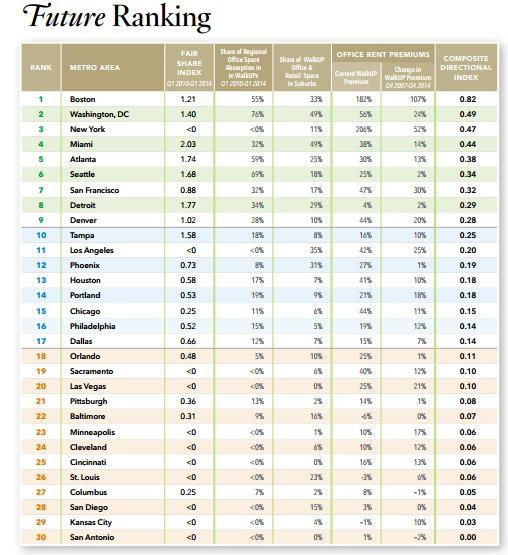Minneapolis is the 12th most “walkable” city in the nation, a report released today shows. It’s one of the few national surveys in which the city finishes behind Cleveland (10).
 The George Washington University School of Business produced the study, called “Foot Traffic Ahead,” to coincide with the opening of a conference in Dallas (one of the least walkable cities) on the new urbanism.
The George Washington University School of Business produced the study, called “Foot Traffic Ahead,” to coincide with the opening of a conference in Dallas (one of the least walkable cities) on the new urbanism.
Minneapolis gets points for having so many jobs in the city, noting that suburbs aren’t appealing to pedestrians.
“These metros have the vast majority of their walkable urban office and retail space in the central city (75 percent to 99 percent), indicating walkable urbanism has not yet spread to the suburbs. This characteristic particularly applies to Portland; despite its national reputation for walkable urbanism, more than 90 percent of its walkable urban space is concentrated within its central city.
Rankings of older industrial metros in this category, such as Pittsburgh, Cleveland, Baltimore, and Philadelphia, may reflect historic, early 20th-century trends. Many of these metros lack significant suburban walkable urbanism and have experienced decades of weaker economic growth and underinvestment in their early 20th-century rail transit systems. However, their center city walkable urban development has been impressive.
Among these moderately ranked metros, Minneapolis and Denver are noteworthy. While most current walkable urbanism is in their central cities, both areas are significantly expanding their light rail systems and the potential of suburban urbanism.”
So Minneapolis gets a boost for thinking about expanding to the suburbs, but, as the Southwest Corridor debate shows, that’s hardly a done deal.
Whatever high ranking Minneapolis gets in current “urban walkability,” it loses in future outlook.
Minneapolis does quite poorly, apparently because more jobs are expected to be located in the suburbs. That, by itself, is not a negative; some high-ranking cities in the survey get a boost from providing “walkable urbanism” in the suburbs.
For other areas, however, suburbs will continue to be designed as suburbs are currently designed.
Atlanta, Boston, and Washington have ended “suburban sprawl,” the report said, which is why they top the list for urban walkability.
The end of sprawl in moderate walkable urban metros in this study largely depends on the question, “Will these metros continue to build predominantly drivable sub-urban, or will they follow the path of high walkable urban metros?” Based on current and future rankings, this analysis predicts the following metros will accelerate their evolution in a walkable urban manner:
• Denver
• Los Angeles
• Portland
• Miami
• Atlanta
Look who’s missing from the list.
“To grow economically, urbanization of the suburbs is a crucial next step for metropolitan areas over the next few real estate cycles,” the report said.
It indicated that while there are champions for a more walkable urbanization of the region, the infrastructure and political leadership here doesn’t seem to exist to make it so in the future.

